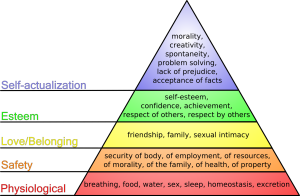Advocacy and Audiences
2 Centering Audiences
Learning Objectives
- Describe how to analyze the formal audience
- Consider implied or implicated audiences
- Explain stereotypes and ethnocentrisms
- Explore strategies for adapting specific elements of a speech for an audience
- Explain ways that an individual can improve their listening when in an audience
We are fans of standup comedy. A well-developed standup routine can leave us engaged and on the edge of our seat; it can leave us feeling like each joke was crafted for us.

Sadly, many of us have sat through less-engaging routines where awkward silence fills the space after an ill-placed punchline.
“Wow. Wrong audience,” the comic often nervously responds.
Similar to standup, audiences are central to all public speeches. Audiences are the main focus of our advocacies, and when we know more about our audiences, we can craft messages that effectively inform or move them toward action. We can craft messages to call them in.
When you speak out, you’re not speaking into thin air; instead, you’re inviting the audience to listen—you’re calling them in. To call in means creating a message that both relates to and implicates your audience; it is to summon. Paul Watzlawick, Janet Beavin, and Don Jackson (1967) write that communication always involves a content dimension and a relationship dimension. Nowhere does that become more important than working to call our audience in. You are not using the speech to dump a large amount of content on the audience; you are making that content important, meaningful, and applicable to them. Additionally, the way the audience perceives you and your connection to them—such as whether there is mutual trust and respect—will largely determine your success with the audience. The speaker must respect the audience as well as the audience trusting the speaker for “calling in” to be a success.
As you can see, calling an audience in is a process, and a complex one at that. In this chapter, we explore audiences in public speaking. To start, we answer the question: what’s an audience, anyway?
What’s an Audience?
In this chapter, we approach the audience in three ways.
First, by “audience” we mean the explicit audience for which the speaker’s message is intended. The explicit audience is composed of two groups: the direct audience and the target audience. The direct audience refers to the people that are present when a speaker directs their message (i.e. the people sitting in chairs or logged into the Zoom call). Once you have found or arranged a direct audience, it can be composed of people with diverse experiences and opinions. Thus, you might choose to focus on specific members who are more likely to be influenced by your appeals and/or more likely to act on them. We call them your target audience. If you are trying to convince your classmates to support a national ban on assault weapons, you might focus on—or target—those who adopt a more expansive or looser interpretation of the US Constitution’s Second Amendment. Because public speeches require an audience, and because public speakers are asking the audience to listen to an argument, it’s important to analyze the group receiving a message – the explicit audience who you are speaking to. This includes both your direct and target audiences.
Second, there are implied or implicated audiences who may or may not be present. Like we discussed in Chapter 1, public speaking is presenting an advocacy that engages for and with your community. When you are representing a group, culture, or an individual, they become an implicit audience. You are responsible for how you communicate about that audience or other groups who may be implicated by the advocacy.
Finally, you will be an audience member. The third dimension of “audience,” then, is you! As an audience member, your primary goal is to listen and reflect on what the speaker is presenting. Listening isn’t as easy as it sounds. So, we’ll also discuss listening, barriers, and best practices.
Who you’re speaking to, who you’re speaking for or about, and when you’re receiving a message are all components of the “audience.” Below, we’ll begin by discussing the importance of audience analysis.
The Importance of Audience Analysis

Valuing your audience is critical not just to being more successful but also to inspiring audience members to work together to improve your communal life. When we value the audience for our speech, a host of questions must be answered. Who is my audience, and what is their reason for gathering or listening? What do I know about them, and what might they expect or need from my speech? To help answer these questions, we employ audience analysis. Audience analysis is the practice of assessing factors that are likely to influence an audience’s reception of a message.
You experience audience analysis in your daily life, although perhaps not always with full awareness. If you read ESPN online, for instance, you are likely exposed to ads for athletic gear, sports betting, and technology. Peruse Glamour online, and you’ll more likely find ads for food (especially sweet treats), medication, and stores like Target. The products reflect the presumed interests of the magazines’ target audiences. Increasingly, ads on the internet are individually tailored to you. If you have recently shopped for a pair of Converse shoes online, for example, then you might suddenly find them advertised on another website you visit. We don’t find this surprising because audience-targeted advertising (audience analysis and adaptation) makes intuitive sense. It also makes our lives easier, since we don’t have to endure (as many) advertisements for products we don’t want.
Similarly, as a speaker you should critically assess your audience. However, we add a significant note of caution: Capitalist consumerism (like the advertisements we mentioned) and civic engagement begin from very different premises and can be at odds with one another. A speech is more than selling a product; ideally, it is about contributing to the public good. Just because something is effective, be it a marketing ploy or a persuasive message, does not guarantee that it is ethical. This differentiation influences our investigation of audience analysis, including the multiple types of audiences you should consider. Below, we’ll begin by discussing the first dimension of audience: those you are speaking to (which includes both your direct and target audiences).
Speaking to an Audience
Public speaking requires an audience. After all, when speaking, your goal is to share a message that’s relevant and provide unique insight that will benefit those present. To accomplish that goal, you need to get to know the explicit audience you’re speaking to: you need to analyze them.
You may wonder, “Okay, but how do I do that?” Information gathering is the answer.
The more information you have, the more you’re able to isolate any overlapping beliefs, values, or goals that the audience shares. Audiences are unique, diverse, and sometimes unpredictable; information gathering will allow you to select an argument that’s most relevant to what your audience needs.
By needs, we mean identifying important deficiencies that we are motivated to resolve.

You may already be familiar with the well-known diagram, Maslow’s Hierarchy of needs (see figure 2.1)—a framework to think about human needs. It is commonly discussed in the fields of management, psychology, and health professions. In trying to understand human motivation, Maslow theorized that, as our needs represented at the base of the pyramid are fulfilled, we move up the hierarchy to fulfill other types of need (McLeod, 2014).
According to Maslow’s theory, our most basic physiological or survival needs must be met before we move to the second level, which is safety and security. When our needs for safety and security are met, we move up to relationship or connection needs, often called “love and belongingness.” The fourth level up is esteem needs, which could be thought of as achievement, accomplishment, or self-confidence. The highest level, self-actualization, is achieved by those who are satisfied and secure enough in the lower four that they can make sacrifices for others. Self-actualized persons are usually thought of as altruistic or charitable.
Unfortunately, humans aren’t always aware of what their needs are, so part of your task is learning about the audience and isolating needs that they may or may not be conscious of. For example, you’re reading out of an open textbook: this book was free of charge. Until you were assigned the book, you may not have been aware that open textbooks (or open educational resources) were an option. It was a need that you weren’t conscious of. A good speaker highlights the presence of a need by relating that issue to their audience.
When addressing an audience, determining what they need and where that need falls on the pyramid can influence how you make content that’s relatable – it can help you call them in. Diving deeper into the speaking context, audience demographics, and audience values all provide necessary information to identify needs and craft relevant arguments.
Researching the Context
Analyzing and understanding your audience’s needs begins by asking top level questions about the public speaking context: why will your audience be there? What’s bringing them together? What’s motivating them to attend? Determining why your audience will be in attendance can help uncover more about who they are.
If you aren’t familiar with the why—why the audience is attending— conduct preliminary research. Use resources that are at your disposal to learn more and dig deep. If you’re speaking at a formal convention, for example, what’s the convention about? Is there a convention theme? Does the convention provide insight into past convention participants? How many people does the event accept?

Your research can help identify what’s bringing the audience together. You might learn, for example, that conference attendees share a common career, participate in a common organization, or have a similar hobby. When you speak in a class, the course content (or university requirement) brings the audience together. If you’re at a neighborhood meeting, the audience likely lives in that neighborhood, and you can learn about the key issues being discussed at the meeting.
As you research, try to determine what’s motivating your audience to be present. Identifying motivations can help assist in identifying what your audience needs or what needs they’re trying to fulfill. For example, if you are presenting the opening keynote to a local professional conference for their industry, your audience may have different motivations for attending. Is your audience required to be present because of a work mandate? Their motivation for being present will differ from someone who is attending an event to learn more about starting their own business, and audience motivations can and should inform the approach you take in your speech. Think back to Maslow’s Hierarchy of Needs: what are the different “needs” that these different audience groups require of the speaker to a) hold their attention and b) engage them to listen longer?
Understanding Audience Demographics
A second information gathering strategy is looking at audience demographics.
Demographics – sociocultural characteristics that identify and characterize populations – are common ways of organizing and gathering data about groups of people. Have you ever taken a survey? Researchers often ask demographic information of participants to determine how answers may change between sub-groups (based on different demographics). In the United States, for example, data might track the average age or the average socioeconomic standing of an incoming college student.
Demographics can be a helpful source of information gathering. If you’re aware of common audience demographics, you can gather information that might glean insights into common beliefs, attitudes, or responses to a topic. Using data and research, like a survey or experimental finding, can help educate you about particular demographic groups that may be in your audience. Figure 2.2 introduces common audience demographics and their corresponding descriptions.
|
Figure 2.2: Audience Demographics and Descriptions |
|
|
Education |
The kind of information and training a person has been exposed to. |
|
Family Status |
The self-identified status of an individual, including married, single, open, divorced. May include children. |
|
Gender Identity |
The self-identified presentation of a gender, including women, men, (cis or trans), and gender non-conforming. |
|
Occupation |
A job, career, or industry that one performs. |
|
Race |
The self-identification with one or more social groups, such as White, African American, Native Hawaiian. Social groups are often defined by common ancestry, cultural markers, or physical characteristics. |
|
Religion |
Beliefs and practices about the transcendent, deity, and the meaning of life; can be thought of as an affiliation and a commitment. |
|
Sexual Orientation |
The self-identification of who an individual based no whom they have relationships with or attraction toward. |
|
Socio-Economics |
A person or group’s economic standing in relation to others. |
Other demographics include ethnicity, gender expression, spirituality, family structure, ability/disability, region or nationality, and generation or age.
Rather than stable categories, demographics are dynamic, changing, and contextual.
Religion, for example, is a porous concept that encompasses a wide range of formal and informal practices. If you gather information about your audience, and you determine that your audience is “religious,” make sure that you aren’t assuming a particular religious affiliation or making assumptions about what the category of religion infers.
While using demographic information can be helpful, it can also lead to stereotyping or relying on totalizing conclusions. Stereotyping is generalizing about a group of people and assuming that because a few persons in that group have a characteristic, all of them do. If we were sitting near campus and saw two students drive by hectically and said, “All college students are bad drivers,” that would be stereotyping. Sadly, our stereotypical thoughts are often reinforced when a group behavior is observed. Every time we see a student (or who we perceive to be a student) driving hectically, we use that observation to support our stereotypical thought. Stereotypes have strongholds, so we likely don’t “count” observations where students are driving safely.
Stereotypes happen when we essentialize by (mis)representing an assumed characteristic of a group and portraying it as the whole, essential, or defining factor. When we essentialize, we assume that a stereotypical characteristic of a group is true of everyone of that group.
For example, imagine that you are presenting a speech at conference, and you learn that a majority of the attendees are women, so you craft your remarks to speak to the experience of motherhood. Can you spot the essentialist tendency here? By assuming all women are mothers and all mothers are women, you have reduced “woman” to one characteristic and approached it as an essential and true component of all women.
We know what you’re thinking: “I never stereotype” or “I never essentialize,” But we all do. Rather than pretend that stereotypes aren’t part of our cultural narrative, use reflective and reflexive thinking to evaluate when a stereotypical thought or idea arises. This includes being reflexive when using demographic information to inform your speech content.
Similarly, individuals are part of multiple demographic categories, not just one. Think about yourself and your identity. What are the key parts? What types of demographics make you, you? You aren’t just one category. Isolating one demographic to represent the whole person is totalizing.
Totalizing is taking one characteristic of a group or person and making that the “totality” or sum total of what that person or group is. Totalizing often happens to persons with disabilities, for example; the disability is seen as the totality of that person, or all that person is about. This can be both harmful to the relationship and ineffective as a means of communicating.
Demographics, then, are part of the information gathering process. But researching your audience’s demographics doesn’t mean learning one category and stopping there. Instead, think about your audience as a complex matrix, and demographics are one component of the grid. To gain a deeper insight into the matrix, search for insight about your audience’s beliefs, values, and attitudes.
Beliefs, Values, and Attitudes
In Chapter 1, we discussed that communication both creates and sustains cultures. All of us are part of different cultures and, through communication, we learn about what those cultures believe and value, often adopting those beliefs for ourselves. For example, why are you in college? It’s likely that you are part of a culture that values education and believes that education will lead to your betterment.
In some cases, groups with similar demographics can hold similar beliefs, attitudes, or values, but not always. Rather than map beliefs onto your demographics, use your research and information gathering to determine what kind of inner beliefs, attitudes, and values your audience may hold.
Beliefs are “statements we hold to be true” (Daryl Bem, 1970).
Notice this definition does not say the beliefs are true, only that we hold them to be true and, as such, they determine how we respond to the world around us. Stereotypes are a kind of belief: we believe all the people in a certain group are “like that” or share a trait. Beliefs, according to Bem, come from our experience and from sources we trust. Therefore, beliefs are hard to change—not impossible, just difficult.
Beliefs are hard to change because of:
- stability—the longer we hold them, the more stable or entrenched they are;
- centrality—they are in the middle of our identity, self-concept, or “who we are”;
- saliency—we think about them a great deal; and
- strength—we have a great deal of intellectual or experiential support for the belief or we engage in activities that strengthen the beliefs.
For example, we (the authors) believe that all genders should be treated equally. This is a belief that we’ve established based on personal experience and cultural narratives. We believe this to be true. This belief informs how we treat people, the things we care about, and what we advocate for. This is a very strong belief, so it would be difficult for a speaker to persuade us otherwise, but would be important information for a speaker to know.
Values are goals we strive for and what we consider important and desirable. However, values are not just basic wants. A person may want a vintage sports car from the 1960s, and may value it because of the amount of money it costs, but the vintage sports car is not a value; it represents a value of either:
- nostalgia (the person’s parents owned one in the 1960s and it reminds them of good times),

Photo by Ola Ola, Pexels, Pexels License. - display (the person wants to show it off and get “oohs” and “ahs”),
- materialism (the person believes the adage that the one who dies with the most toys wins),
- aesthetics (the person admires the look of the car and enjoys maintaining the sleek appearance),
- prestige (the person has earned enough money to enjoy and show off this kind of vehicle), or
- physical pleasure (the driver likes the feel of driving a sports car on the open road).
In the United States, for example, you might speak to an audience that values monetary security and success. This value is informed by a belief. It’s likely, for example, that values around monetary success and prestige are rooted in beliefs that individual hard work can achieve success in a capitalist society. If you can identify a value, ask: what could be fueling that value? What beliefs?
Finally, attitude is defined as a positive or negative response to a person, idea, object, or policy. How do you respond when you hear the name of a certain singer, movie star, political leader, sports team, or law in your state? Your response will be either positive or negative, or maybe neutral if you are not familiar with the object of the attitude. Where did that attitude come from? Does that person, idea, or object differ from you in values and beliefs?
Let’s extend our monetary example from above. If you speak to an audience who believes in capitalism and values monetary, individual success, it may be unwise to mention “socialism” as the audience may have a negative attitude to socialism as a concept.
Consider this second example. Pretend that you’re speaking to a campus audience and, currently, the university has a very popular campus leader. The audience likely has a positive attitude toward that leader, so it would be beneficial to quote that person in the speech itself.
The discrete categories of beliefs, values, and attitudes are often intertwined, and knowing more about these categories can add to your understand of who the audience is. Knowing who they are means identifying their needs and determining how and why your speech is relevant.
Speaking for an Audience
Gathering information about your explicit audience—the formal audience you’re speaking in front of and those your message is intended for—is certainly important. The second audience to consider is the implied or implicated audience. In this section, we discuss how we talk about who we’re talking about: how we’re talking about the groups that are either represented and/or affected by our message.

Public domain, via Wikimedia Commons
Let’s use a state congressional hearing as an example. Imagine a group of congress people meeting to advocate for a bill’s passage that decreases environmental protections for a city in that state. The bill’s author stands and advocates passionately for the bill’s passage, noting that reducing the environmental protections would allow more business and jobs in the area. The speaker works to craft an argument that’s compelling for the explicit audience – the audience of other congress people who are present.
However, there are other implied audiences – the communities that would be most impacted by environmental pollution; residents who live in the area; business owners themselves. These audiences are important because they are both represented in the advocacy and would be impacted by the results of the speech. They may not, though, be part of the explicit audience.
It may seem odd to consider audiences that are implied or not present. After all, isn’t the explicit audience who you’re trying to inform, persuade, or entertain? Yes, your explicit audience is important, but as we discussed in Chapter 1, communication is constitutive. When you communicate or advocate for an idea, you are participating in world-making. The way that you talk or represent groups, cultures, or individuals has lasting impacts, even outside your explicit speech event. It can impact your implied audience. So, the “talk” about an implied audience matters.
Asking ourselves to be accountable to implied audiences also encourages us to use ethical communication, pay attention to power, and reduce stereotypes.
Ethnocentrism—or the belief that one’s own culture is superior— should be avoided because it often represents other cultures in unethical, stereotypical, or unjust ways. If the speech’s argument requires an ethnocentric perspective, the argument isn’t based on good reasons.
So far, we’ve discussed your implied and impacted audience as groups that are discussed, represented, or implicated by your speech. A final implied audience includes any groups, cultures, or an individual’s ideas that you’re using.
Have you ever had a friend who re-tells your joke but doesn’t give you credit? Not cool! The same is true for speech advocacies. Any time you use or adapt an idea from a group or individual, you must give that implied audience credit. Failing to do so is known as plagiarism, or representing someone’s ideas as your own . Once you’ve finished writing an outline, make sure to double-check that anyone and everyone’s information has been properly cited.
Identifying your implied audience can take time, but don’t worry. We’ll continue building critical thinking skills throughout the book to practice ethical and just public speaking with your explicit and implied audience in mind.
What Is Audience Adaptation?
So far, we have established audience analysis as the practice of assessing factors that are likely to influence an audience’s reception of a message. So what do you do with all the insights and information you gain about your audience? Next, we explain audience adaptation, or the ways you alter your speech, using audience analysis cues, to better achieve your speaking goals. We begin by establishing the importance of adapting your speech to your audience. We follow with specific strategies you can use to connect with and engage your audience. We end by addressing how rhetoric allows you, as a speaker, to work with your audience in imagining a more productive future together.
Too often, student speakers make one of two mistakes when drafting and presenting their speeches.
- One mistake is that they don’t think enough about delivering it to an audience. They approach their speech similarly to writing an essay they will submit only to the instructor.
- A second mistake is that speakers assume their audience is just like themselves. They deliver a speech they personally find compelling and assume their classmates will too.
Both mistakes result in similar consequences: speeches that fail to connect with the audience. They center the needs and interests of the speaker rather than their audience. You might even call these speeches selfish or self-focused. Accordingly, they do not create a sense of community or compel the audience to address communal issues.
Adaptation corrects both mistakes. It approaches a speech as public address—that is, as communication with and to a public audience. The audience is critical to a speech. Without an audience, there is no speech! Adaptation also recognizes that your audience is not the same as you, the speaker. Your and your audience’s demographic and psychological factors may overlap, but they also likely differ. Audience adaptation, then, prompts you to adjust, or adapt, your speech to center the audience’s needs. We next offer strategies for making such adaptations.
Audience Adaptation Strategies
What do we mean by adapting your speech? We offer seven specific strategies you can (and should) utilize in crafting your speech: own your message, find common ground with your audience, use appropriate language, adjust the depth and complexity of the content, appeal to deeply held values, use compelling supporting appeals, and select credible and familiar sources.
As we explore each strategy, we assume you will use these strategies mostly for your direct and target audiences. Recall that your direct audience are the people who are exposed to and attend to your speech. Your target audience includes specific members of the direct audience who are more likely to be influenced by your appeals and/or more likely to act on them. When appropriate, however, we note ways your adaptation efforts should also be mindful of your implied audience (a group that is represented in your message) and your implicated audience (those affected by your message if it succeeds).
Box 2.1 Strategies for Adapting to Your Audience
- Own the message.
- Find common ground.
- Use appropriate language.
- Adjust the depth and complexity of content.
- Appeal to deeply held values.
- Use compelling supporting appeals.
- Select credible and familiar sources.
Own Your Message
Though it may seem counterintuitive, one of the first strategies to remember when adapting to your audience is that you, as the speaker, must continue to own the message. That is, your efforts at audience adaptation must not compromise your voice and vision. Your intent is not to tell the audience what they want to hear or what is popular. Instead, maintain your authenticity as you connect with the audience and make your message relevant to them.
Find Common Ground

At the center of audience adaptation is the effort to find common ground or, as literary critic Kenneth Burke says, to develop identification (Burke, 1950/1969). Identification is the degree to which individuals or groups find themselves joined or linked. For Burke, identification is the primary means of persuasion and occurs when audience members feel a connection with the speaker. When we identify with someone, we also can share a view of life, demonstrate similar values, or develop a sense of trust.
In terms of audience adaptation, the speaker can cultivate identification in several ways. You may explicitly reference what you hold in common, such as demographic factors (your shared age, geographic region, political affiliation, etc.) or psychological factors (your shared personal stakes, knowledge about the topic, or enthusiasm for the occasion). Alternatively, you can foster identification more implicitly through your verbal style (chapter 9), vocal and nonverbal delivery (chapter 11), use of visual aids (chapter 12), and the other adaptation strategies we will offer.
You have undoubtedly experienced several means of identification in everyday life. Perhaps you’ve talked with a stranger wearing the hat of your favorite sports team or your college’s T-shirt. The connection and sudden comfort you felt came from identification. As a speaker, you hope to make adaptations, based on information gleaned from analysis, that create a connection. Your adaptations should be authentic, though, or they could backfire. For instance, a group of ranchers probably won’t take seriously a city slicker who shows up wearing a cowboy hat and suddenly starts talking with a drawl.
Identification also occurs through division, which can function as a quality of unproductive discourse when speakers highlight and accentuate differences with other participants and their positions. We can also think about division, however, more positively as a tool you can use to adapt to your audience. People might identify with each other through their shared distaste for (division from) a rival sports team or college, for instance. You might build an audience through your joint frustration with the local school board.
Be careful with using division to foster identification with your direct or target audience, however. Division is often built on the rejection of an absent implied or implicated audience. Calls to “strengthen” or “close” the US/Mexico border, for instance, attempt to form identification among a group of U.S. citizens by dividing them from migrants. In this case, migrants (and others) form the implied and implicated audiences, because they will be impacted by these policies and are being indirectly represented in the discourse, but they are not typically part of the direct audience. Unethical speakers may capitalize on that absence, oversimplifying or even dehumanizing implied and implicated audiences to connect with their target audience.
Ethical speakers, in contrast, recognize the power of their speech and adjust it to also account for the humanity, experiences, motives, and actions of the implied and implicated audiences. They may still advocate for a more stringent immigration policy (that is, they can still own their message), but they will find alternative ways to identify with their direct audience.
Use Appropriate Language

Another way to adapt to your audience is to use appropriate language for your direct and target audiences. Think for a moment about our common expectation that our teachers, doctors, lawyers, and religious leaders adjust what they teach or say to our level and specific needs and interests. We would be frustrated with a professor who spoke to a college class with the same vocabulary with which they write a journal article for specialists. In speaking situations, you should adjust your language based on audience characteristics such as age, education, and knowledge. This means altering the complexity of your language—the amount of technical language you use and even the possible use of popular slang terms—depending on the audience and situation. If you don’t, the audience is likely to tune you out.
Adjust the Depth and Complexity of Content
Audience adaptation also means adjusting the depth of information presented on a topic and its complexity. Consider your direct and target audiences’ familiarity with, or knowledge of, a topic as you assess how much background information is needed. Likewise, adjust the depth and complexity of your content based on situational factors such as the time available to speak and the purpose of the occasion.
It is frustrating when a speaker spends significant time explaining an idea or event that the audience already knows about. In that case, the speaker squandered an opportunity to address what attracted the audience to the presentation by rehashing common knowledge. Adapting to the needs and knowledge of the audience ensures your presentation will be relevant and timely.
Appeal to Deeply Held Values
Another way to adapt to your direct and target audiences is by appealing to values they identify as important. Demonstrating in a speech how a problem violates or jeopardizes a deeply held value motivates an audience. Similarly, explaining how a particular action or decision will advance an important value makes an audience more likely to lend their support. Common values that work in such a fashion in the American context are freedom, justice, and equality. Value appeals are explored in more depth in chapter 15’s discussion of deliberation.
Use Compelling Supporting Appeals
One of the most effective ways to employ audience adaptation is through supporting appeals. In general, you want to use diverse forms of evidence as discussed in chapter 5: examples, statistics, and testimony. However, you don’t have to use them in equal amounts. You might, for example, employ more numerical data if most of your direct audience—classmates in this case—are pursuing studies in the natural or social sciences. If you are speaking at a protest rally, however, your direct audience might find quotes by several eloquent leaders about your cause to be more compelling.
Whomever your direct or target audiences are, examples can be impactful if they reverberate with your listeners. As defined in chapter 5, an example is a concrete instance that supports a broader point or conclusion. However, if a selected example is unfamiliar to the audience or too obscure, it is unlikely to be effective. Similarly, an anecdote—a story or extended example in narrative form—can nicely draw an audience in, but only if it’s an already familiar story or features values esteemed by the audience. Box 2.2 extends this logic to your use of metaphors.
Box 2.2 Using Sports Metaphors to Support Your Message
Metaphors compare two items or situations. Because of their popularity, sports are frequently drawn on to make comparisons:

- A heroic effort is characterized as “swinging for the fences.”
- A successful effort is a “touchdown.”
- An intense effort is described as a “full-court press.”
- A desperate effort is labeled a “Hail Mary.”
Sports metaphors can be very effective for some audiences but not all. Think about your audience’s interests and the relevance particular metaphors may or may not have for them.
Select Credible and Familiar Sources
Finally, even your sources can be adapted to your direct and target audiences. As discussed in chapter 4, you should set the evaluative standard, or bar, high when choosing research materials by judging each source by its BAARR: potential bias, accuracy, authority, recency, and relevance.
However, you should also consider which sources your audience likely holds in high esteem. It is one thing if you use a source to support your claim, and it is quite another (and very helpful) if your audience knows and respects that source. Don’t assume all groups value the same sources. Quoting the Bible or Koran, for example, may help sway fellow members of your church or mosque, but these sources are less likely to compel classmates at a nonreligiously associated university.
Box 2.3 Sample Audience Analysis and Adaptation
Lisa wanted to prepare a speech for class on the benefits of community supported agriculture (CSA) as a valuable source of local, organic food.
Audience Analysis
-

Image by congerdesign via Pixabay, Pixabay Content License. Demographic factors: Lisa realized most of her audience members were eighteen to twenty-three years old, lived in campus housing and were on a school dining plan, and had minimal disposable income. Many were also athletes and did not own cars. She concluded that they valued economic responsibility, proximity, and health.
- Psychological factors: Through a class survey, Lisa also learned most of her classmates were from urban areas and thus were likely unfamiliar with either growing their own food or CSAs.
- Environmental factors: Lisa knew her class met right before lunch, when her classmates would be hungry.
Audience Adaptation
- Find common ground: Lisa referred to herself as a fellow student living in the residence halls who shared a desire for more healthy options on or near campus.
- Adjust the depth of the content: She gave a brief explanation of how CSAs work and why they got started before advocating that their college offer CSA shares to students as part of their meal plans.
- Use compelling supporting appeals: Lisa handed out several fresh fruits and vegetables she had purchased from the local farmers’ market. She used them as examples of the kinds of produce available through a CSA.
Lisa crafted specific appeals that engaged her peers and centered their needs and values. She practiced audience adaptation.
Adaptation, Not Manipulation
Before leaving the strategies, we offer a final warning. Adaptation does not mean saying what the audience wants to hear or what is popular. Nor does it mean manipulating the audience to achieve your desired response. Ethical speakers do not mislead or prey upon their audience, whether by magnifying fears or promising the fulfillment of personal desires.
Instead, we adjust our speech to help make messages more meaningful to our audience, centering their needs, stakes, and interests. As a speaker, you are speaking “with” an audience, not “to” or “at” them. Ideally, adaptations enable you to talk to and work with the audience to address issues together and improve your communities. The point is that speakers need to examine the ethics of their alterations and be mindful that adaptation and manipulation are not the same, nor are they equally acceptable.
Imagining the Future Together
So far we have concentrated on adapting to an audience based on your analysis of who they are. Before closing, however, there is another dimension of audience adaptation to consider, one that is particularly important in efforts at civic engagement: who your audience wants to be and how you can all work together to accomplish that vision.
That is, in considering your direct or target audience, you are not restricted to who they are now. Rather, you can offer a vision of who they can become as they strive with you to create a better future together. The ideas you address in your speech can be framed as opportunities for your audience to grow and thrive, thus making them more attractive to subscribe to.
Box 2.4 Terps Who Help Us Imagine the Future

We can look to University of Maryland students and alums for examples of Terps who help audiences imagine the future together:
- Get Ovary It championed menstrual equity on campus, resulting in the installation of hundreds of free menstrual product dispensers and shifting campus culture through grassroots advocacy and collaboration.
- IMPACTdmv empowers the next generation of leaders in the DC Metropolitan Area, with a strong focus on Prince George’s County, by guiding high school seniors through innovative programs that have resulted in hundreds of college acceptances and millions in scholarships.
- Roots Africa, since starting as a student-led organization to combat hunger and poverty in Africa, has championed a collaborative model that connects sustainable agriculture experts to farming communities in Liberia and Uganda, training thousands of farmers.
These speakers, featured in the immersive Students Change the World exhibit, offer more than just stories – they offer a vision. Through their words, they invite audiences to imagine their role in a future defined not by what is, but by what could be.
Listening as an Audience Member
The third component of “audience” includes you! You will be an audience member many, many times, and you should take that job seriously. Your job in the audience is to listen and ethically reflect on what the speaker is saying. In this section, we explore listening as a key audience concept.
Listening is not the same thing as hearing. Hearing is a physical process in which sound waves hit your ear drums and send a message to your brain. You may hear cars honking or dogs barking when you are walking down the street because your brain is processing the sounds, but that doesn’t mean that you are listening to them. Listening implies an active process where you are specifically making an effort to understand, process, and retain information.
In an audience, listening can be a difficult process. Unlike reading, which allows you to re-read a passage, you often have one chance to listen to an argument in a speech. Many studies have been conducted to find out how long we remember oral messages, and often the level of memory from oral communication is not very high (Bostrom & Bryant, 1980). The solution? Try to enact different listening techniques and reduce your barriers to listening.
Types of Listening
In this section, we will focus on types of listening. Ideally, we recommend working toward comprehensive or active listening, which is listening focused on understanding and remembering important information from a public speaking message. There are other “types” of listening, based on the context and purpose.
The first is empathetic listening, or understanding the feelings and motivations of another person, usually with a goal of helping. For example, if a friend says that she is thinking about dropping out of college at the end of the semester, you would want to listen for the reasons and feelings behind her choice, recognizing that you might need to ask sensitive questions and not just start telling her what to do or talk about your own feelings.
The second type of listening is appreciative, which takes place while listening to music, poetry, or literature, or watching a play or movie. For example, knowing that the melodies of classical musical have a certain A-B pattern informs us how to listen to Mozart. To be good at this kind of listening, it helps to study the art form to learn the patterns and devices.
The third type is critical listening. In critical listening the audience member is evaluating the validity of the arguments and information and deciding whether the speaker is persuasive and whether the message should be accepted. This often occurs when listening to persuasive arguments.
What can an audience do to encourage listening for an audience?
Planned redundancy refers to purposeful ways of repeating and restating parts of the speech to help the audience listen and retain the content. You might not be able to cover or dump a great deal of information in a speech (and you probably shouldn’t), but you can make the information meaningful through planned redundancy and repeating or underscoring key components of your argument.
In short, listening is hard work, but you can meet your audience half way by using certain strategies and material to make listening easier for them. At the same time, an audience member has a responsibility to pay attention and listen well.
In the next section, we will look at how you can improve your listening ability in public speaking situations.
Barriers to Effective Listening
Since hearing is a physiological response to auditory stimuli, you hear things whether you want to or not. Just ask anyone who has tried to go to sleep with the neighbor’s dog barking all night. However, listening–really listening– is intentional and hard work. And there are three common barriers to be conscious of.
Noise – physical and mental – is the first barrier to listening. We have constant mental distractions in our lives, something that you might not even be aware of if you have always lived in the world of Internet, cell phones, tablets, and 24/7 news channels. We are dependent on and constantly wired to the Internet. Focus is difficult. Not only do electronic distractions hurt our listening, but life concerns can distract us as well. An ill family member, a huge exam next period, your car in the shop, deciding on next semester’s classes—the list is endless.
Box 2.5: Banning Cell-Phone Bans in Schools

The presence of cell phones in K-12 schools is a current subject of debate among parents, students, staff, and administrators across the nation. Baltimore City Public Schools recently updated their policy for the 2025-2026 academic year. Under the new policy, “students may bring devices to school, but they must be powered off, away, and secured during the school day.” Some argue that this policy reduces the mental and physical noise for students so they can better better focus on learning. Others argue that students should have access to their phones in case of an emergency and during breaks like lunch.
What do you think?
Physical noisiness and distractions also contribute to difficulty listening. Perhaps someone next to you is on their cell phone, and you hear the constant click of their keyboard. Perhaps they are whispering to each other and impeding your ability to hear the speaker clearly. The physical environment can also exert noise. Maybe it’s raining outside or someone is vacuuming through the door.
Confirmation bias is a second barrier to listening. This term means “a tendency to search for or interpret information in a way that confirms one’s preconceptions” (Nickerson, 1998). Although the concept has been around a long time, we are more aware of confirmation bias today. It leads us to listen to news outlets and Internet sources that confirm what we believe already rather than being challenged to new ways of thinking by reading or listening to other sources of information. It can cause us to discount, reject, or reinterpret information to fit our preconceptions.
Finally, information processing is the third barrier. Our minds can usually process much faster than a speaker can speak clearly. We may be able to listen, when really trying, at 200 words per minute, but few speakers can articulate that many words clearly; an average rate for normal speech is around 100-120 (Foulke, 1968). That leaves a great deal of time when the mind needs to pull itself back into focus. During those gaps, we might find it more enjoyable to think of lunch, the new person we are dating, or our vacation at the beach.
These are all the possible obstacles to listening, but there might also be reasons that are particular to you, the listener. We often go into listening situations with no purpose; we are just there physically but have no plans for listening. We go in unprepared. We are tired and mentally and physically unready to listen well. We are hungry or fatigued. We do not sit in a comfortable position to listen. We do not bring proper tools to listen, specifically to take notes. So, what do we do?
Intentional Listening
As audience members, barriers prohibit our ability to absorb information that could benefit us.
Your own barrier might be not coming prepared, being quick to prejudge, or allowing gadgets to distract you. Obviously, recognizing the cause of your poor listening is the first step to becoming a better listener. Here are some steps, in summary:
- Practice the skill. Believe that good listening and improving your own listening are important. You would not want to be called upon in a meeting at work when you were daydreaming or being distracted by a cell phone. Consider listening to speeches in a prepared manner and practice listening as a skill.
- Practice reflexive listening. Since it is so easy to react to a speaker’s ideas with confirmation bias, go into listening knowing that you might disagree and that the automatic “turn off” tendency is a possibility. In other words, tell yourself to keep an open mind.
- Be prepared to listen. This means putting away mobile devices, having a pen and paper, and situating yourself physically to listen (not slouching or slumping). Have a purpose in listening. There is actual research to indicate that we listen better and learn/retain more when we take notes with a pen and paper then when we type them on a computer or tablet (Mueller & Oppenheimer, 2014). Situate yourself by making decisions that will aid in your listening.
Box 2.6 Electronic Devices and Listening: What Are the Ethics?
Should you use a tablet or laptop while listening to a presentation? Is it ever OK to access your smartphone while listening to a speaker?
Potentially Productive uses of Electronic Devices in a Speaking Situation Unproductive uses of Electronic Devices in a Speaking Situation - Note-taking
- Fact-checking
- Interacting with supporting materials
- Participating in talk-related surveys and quizzes
- Looking up the meaning of terms used in the talk
- Posting feedback—many conventions and workshops assign official hashtags to inspire participant communication via social media
- Web surfing
- Checking and composing personal emails
- Checking and posting status updates on social media sites
- Gaming
- Using smartphones that beep or ring during presentations—even loud vibrations from hard surfaces can be disruptive
Be mindful that use of electronic devices, even use that we think is discreet (such as looking at a cell phone under a table), can often be seen by the speaker and can disrupt other audience members. Give speakers your attention and respect, and also ensure you can effectively retain and evaluate information.
- When taking notes, keep yourself mentally engaged by writing questions that arise. This behavior will fill in the gaps, create an interactive experience with the speaker, and reduce the likelihood that your mind will wander. However, taking notes does not mean “transcribing” the speech or lecture. Whether in class or in a different listening situation, do not (try to) write everything the speaker says down. Instead, start with looking for the over-all purpose and structure, then for pertinent examples of each main point. Repetition by a speaker usually indicates you should write something down.
- Communicate nonverbally. The public speaking event is created by both the speaker and audience members, and providing nonverbal feedback to the speaker can help you stay physically engaged. In fact, how you interact with the speaker can impact the context, the engagement between audience member/speaker, and comprehension. A study by Rubin et all (2022) found that, when audience members were communicating an interest in the speech through nonverbal communication, the speaker was more likely to orient or engage that audience member.
Conclusion
Audiences are central to a speaker’s success. All 3 audience dimensions are key to consider, whether you’re speaking or listening. Audience adaptation ensures that you center the needs and interests of your audience rather than yourself as a speaker. Use this chapter throughout the public speaking process to create a relevant argument that’s engaging to your audience. Work to call them in: to summon them to actively listen to your advocacy.

